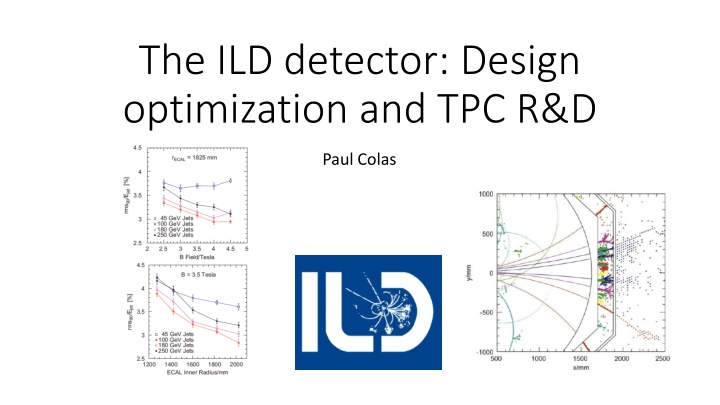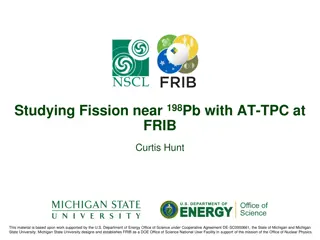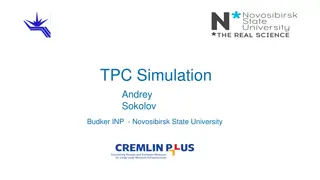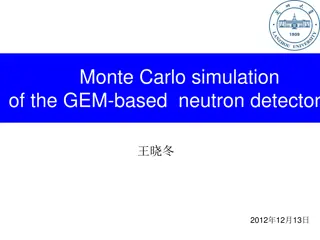Advances in ILD Detector Design and TPC R&D
Explore the latest developments in ILD detector optimization and TPC research, focusing on enhancing event reconstruction accuracy and energy resolution. Learn about the ILD concept based on particle flow, the ILD group activities, organizational structure, technical advancements, and TPC readout technologies. Dive into the collaboration efforts in TPC R&D by the LCTPC and DESY test setup, aiming to improve efficiency and cost-effectiveness for future experiments.
Download Presentation

Please find below an Image/Link to download the presentation.
The content on the website is provided AS IS for your information and personal use only. It may not be sold, licensed, or shared on other websites without obtaining consent from the author.If you encounter any issues during the download, it is possible that the publisher has removed the file from their server.
You are allowed to download the files provided on this website for personal or commercial use, subject to the condition that they are used lawfully. All files are the property of their respective owners.
The content on the website is provided AS IS for your information and personal use only. It may not be sold, licensed, or shared on other websites without obtaining consent from the author.
E N D
Presentation Transcript
The ILD detector: Design optimization and TPC R&D Paul Colas
The ILD concept Based on Particle Flow: reconstruct the event by matching calorimeter objects with charged tracks (use the most precise E-p determination, avoid double count between tracks and E objects Continuous tracking (TPC) and highly segmented calorimeters Optimize jet energy resolution .vs. B, RTPC, ECAL cell size : 3.5T, 1.7 m or 1.4 m, 1cm or less (MIP subtraction) Vertex detector for b and c hadron recon- struction (jet charge) : 4 m resolution
The ILD Group Currently 68 groups signed up ILD activities matrix 25 Region of Origin 20 50 15 40 10 30 5 20 10 0 0 AM AS EU Costing
The ILD Organization Born from the fusion of GLD (mainly Asian) and LCD (mainly EU) LOI in March 2009, Detector Baseline Document in 2013 One spoke (Ties Behnke, elected in 2015) One deputy spoke (Kiyotomo Kawagoe, nominated in 2016) An Institute Assembly (68 members, one per institute) An Executive Team A Technical Board, chaired by the Technical Coordinator (Claude Vall e nominated in 2016) A Physics Group (Physics Coordinator Keisuke Fujii) A Software Group (Software Coordinator Frank Gaede)
TPC Readout Technologies MPGDs suffer less from ExB effects than MWPCs. They require less heavy mechanics. Panels with each technology have been made and tested. European GEMs Micromegas Standard kapton triple GEM with ceramic spacers Mesh on top of a charge-dispersing resistive anode GridPix Integrated grid on 55 digital pixels Asian GEMs
TPC R&D: The LCTPC collaboration and the DESY test setup All the TPC R&D is gathered. www.lctpc.org The collaboration shares a test facility (Field cage, magnet, endplate, cosmic-ray trigger, ancillaries) Allows testing/comparing several technologies/ideas with cost-awareness
Beam and cosmic-ray tests Beam test in DESY magnet Cosmic-ray test at Saclay
Charge spreading by resistive foil Resistive coating on top of an insulator: Continuous RC network which spreads the charge: improves position sensitivity M. Dixit, A. Rankin, NIM A 566 (2006) 28 Various resistive coatings have been tried: Carbon-loaded Kapton (CLK), Diamond-like Carbon (DLC) and resistive ink (3-5 M /sq) In addition the resistive foil suppresses sparks.
Charge spreading by resistive foil Gaussian spreading as a function of time with r = sqrt(2t/RC) t~shaping~few 100 ns RC = 180 R(M ) /(d/175 ) ns/mm For R= 2 Mohm/sq, shaping 200 ns, 200 insulation in addition to the 50 m kapton, one obtains sigma = 1.3 mm (For 0.2 Mohm/sq, we would have sigma= 3.16 mm) M. Dixit, A. Rankin, NIM A 566 (2006) 28
Pad response Relative fraction of charge seen by the pad, vs x(pad)-x(track) Z=20cm, 200 ns shaping 24 rows x 72 columns of 3 x 6.8 mm pads x(pad) x(track) (mm) 03/04/2018 13
ENCAPSULATED RESISTIVE ANODE DESIGN Spreading : Resistive layer connected to the guard ring with 28 03/04/2018 14
Results on resolution All pad TPC technologies give similar results (but with 3mm pads for MM and 1.2mm pads for GEMs) 28/02/2017 Paul Colas - A TPC for ILC - INSTR17 15
Results on resolution All pad TPC technologies give similar results (but with 3mm pads for MM and 1.2mm pads for GEMs) 28/02/2017 Paul Colas - A TPC for ILC - INSTR17 16
S. Voronov, M. Zito, PC dE/dx resolution of a resistive-anode TPC OK for T2K2 OK for ILD TPC : 5.0% 03/04/2018 17
TPC design and integration :electronics integration D. Calvet et al., IEEE trans.
TPC design and integration : mechanical integration Deformations under weight and inner pressure M. Carty, P. Manil et al. Resuming : Zhihong Sun et al.
TPC design and integration : 2-phase CO2 cooling Advantages: Specific heat 4 x water Latent heat for evaporation : 80 x water Boiling point at room temperature at 60 bar Inexplosive, non-conductive, vapors instantly at 1 atm. Tested in our test beam in 2014 and 2015
Cables, services, power consumption, All details are written in a TPC Interface Control Document. Serious issues from push-pull operation. Ion back-flow, Gating IBF naturally suppressed in Micromegas. However a gating might be necessary, under study. One possibility demonstrated: large opening GEM, could be integrated to the modules.
Conclusions The ILD collaboration is coming to life Proof-of-principle of a Micromegas TPC done (GEMs have similar performances, the difference will be in complexity/reliability) Getting ready for the technology choice (S. Ganjour, K. Fujii et al., TYL) Solutions for integration demonstrated, but still lots of studies in progress to make the detector a reality ILD members from Irfu: ATTIE David; BERRIAUD Christophe; Besancon Marc; COLAS Paul; FOURCHES Nicolas; GANJOUR Serguei; Giomataris Ioannis; NAPOLY Olivier; SHARYY Viatcheslav; TITOV Maksym; Tuchming Boris;






















